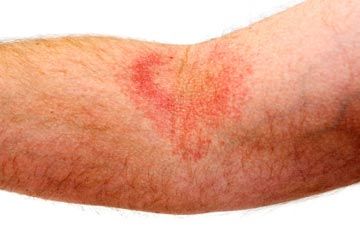It's a winter wonderland outside, and you're ready to hit the slopes. You've got thermal underwear, a knit hat and scarf, gloves, and even a nice thermos of cocoa to keep you warm. But if you want to protect yourself from the weather, you've forgotten about one thing: your skin.
Whether it's cold and dry or hot and humid, an area's climate can really affect the skin all over your body, causing everything from acne breakouts to itchy dry patches. Extremes in weather -- both hot and cold -- can exacerbate some existing skin conditions or even cause new ones.
Advertisement
Colder climates can be tough on your skin. Cold temperatures often mean low humidity, which dries out skin. Bitterly cold winds can also strip moisture from exposed skin. Throughout the winter months, many people find their skin to be rough, red, tightened, cracked or peeling because of dryness. To treat a mild case of dry skin at home, avoid taking long, hot showers, and apply a moisturizer daily. If your condition is severe, a doctor might be able to prescribe a medicated cream [source: Mayo Clinic].
Some skin conditions, such as eczema, can flare up during dry weather. Avoid long soaks in the tub, don't let the water get too hot and use a mild soap to help soothe your skin. Finally, moisturize every day to keep eczema under control [source: American Academy of Dermatologists].
No matter what the weather is like, the sun should always be a main concern. Exposure to sunlight is one of the major causes of wrinkles and premature aging, so wearing a high SPF sunscreen can keep your skin looking young and fresh [source: Goins]. Even when it doesn't feel hot, the sun's rays can damage your skin, so apply sunscreen every day -- even if it's cold or cloudy.
In warmer climates, increased heat and humidity can cause your skin to sweat, leaving you more prone to breakouts, especially if your skin is oily. Using a cleanser with salicylic acid can help dry up some of the oil, but it can also make your skin more sensitive to sunlight, so use caution and apply these products at night [source: Goins].
The heat can also lead to other skin problems. Among them is heat rash, which happens when sweat ducts get closed off, trapping the moisture under the skin and leading to a rash made up of blisters or bumps. The condition is common in infants, but it can also affect adults who are exposed to hot, humid climates. Heat rash usually disappears on its own in three to four days, but if you notice an increase in pain or swelling, swollen lymph nodes, a fever, or chills, seek medical attention rather than treating the condition at home [source: Mayo Clinic].
To learn more about how to protect your skin from chilly winters and steamy summers, visit the links on the next page.
Advertisement

